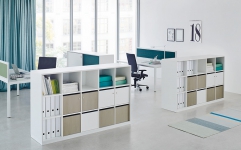ThyssenKrupp
Our reference: ThyssenKrupp
ThyssenKrupp is a globally operating group specialising in the strategic field of materials and technologies. Their range of services and products varies from high-performance materials and equipment, components, systems to innovative services. With 177,000 employees, the company generates sales of €42 billion.
Architects
The ThyssenKrupp Quarter was developed as a joint design by JSWD architects from Cologne in collaboration with Chaix & Morel et associés based in Paris.
The projet: ThyssenKrupp Quartier
It consists of a cluster of individual buildings embedded in a green, tree-studded carpet. The consortium of architects from Cologne and Paris grouped twelve buildings on a 17 hectare campus around a central ordering axis consisting of a large water basin and the “Avenue of the Worlds” lined with 200 trees from all over the world.
Thus the headquarters is also an architectural representation of the most important resources of the 21st century: knowledge and human expertise. The company’s return to the Ruhr area is a clear commitment to the region where ThyssenKrupp has its origins. The group’s history began with a small cast steel factory named Krupp here in Essen in 1811 and now it is continued here.
Q1, the headquarters
….. is the heart of the new ThyssenKrupp quarter. More than 500 people work in the cube-shaped building. The geometric interlinking of the two L-shaped structural elements around a shared central space not only creates an exciting exterior, but also provides for interesting room sequences inside the building.
Q2 forum
The Q2 forum is the place for meetings, communication and project work. International project teams work in the Q2 forum, and this is also where the Group receives its guests. The main conference and events hall can seat up to 1,000 people. The building also houses the staff canteen “Zwischenzeit” and the guest restaurant.
Q5 and Q7
There are two more buildings on the campus, each consisting of two L-shaped structures. Some 220 employees work in Q5, and around 300 in the Q7 building.
Sustainability
The Q1 headquarters received the pre-certificate in gold awarded by the Deutsche Gesellschaft für Nachhaltiges Bauen (DGNB e.V) (German Society for Sustainable Building).
The expected primary energy requirement falls below statutory provisions by 20 – 30 per cent. Comparable economical buildings, particularly buildings with appreciable glazing, have rarely been constructed in Germany up to now.
The ThyssenKrupp Quarter is equipped with a geothermal plant which utilises heat and cold stored in the ground by means of energy probes. The plant is not only able to heat and/or cool the building, but also surplus heat and cold in the ground can be stored seasonally. The room temperature is maintained between 21 and 26° C with this technology. The discharged air from the offices is utilised through heat recovery by the central ventilation system. The system has a high heat recovery factor and represents the sustainability of the building.
Awards – architecture
- Nominated for DETAIL Award 2011 in the corporate entrepreneur award category
- pbb architecture award for commercial buildings 2010, pbb Stiftung Deutsche Pfandbriefbank
- Guter Bauten 2010 (Good Building Award), BDA Essen
- AIT innovation award architecture + glass
- Architecture award of the city of Essen
Modern workplace design
With their decision in favour of the new construction of its company headquarters, ThyssenKrupp also pointed the way to new workplace design in the group. In collaboration with the Fraunhofer Institute and architects, an office concept was developed for the ThyssenKrupp Quarter which meets diverse modern workplace requirements.
What are the features of well-designed offices today? They support innovation processes and improve meeting quality. At the same time, it must be possible to perform individual work and team work intently. Mobile workflows enable simple integration of external workers. Formal and informal communication is supported by the diverse rooms and available working space for conferences and meetings.
The offices meet all safety requirements and feature optimum working space management. By creating maximal transparency and flexibility, they also support communication among employees, thus contributing significantly to the implementation of corporate culture.
Implementation by ophelis
As an industrial company with a clear focus on serial production in high quality, we nevertheless offer made-to-order and individual solutions for our customers as a key component of the ophelis strategy.
We supplied 4,000 cupboards and caddies for the ThyssenKrupp Quarter – our individual solution exactly adapted to customer and architectural requirements was convincing.
ophelis developed for ThyssenKrupp a special sliding door cupboard with attractively designed handles offering 100% access to the cabinet contents without dead space due to protruding doors.



